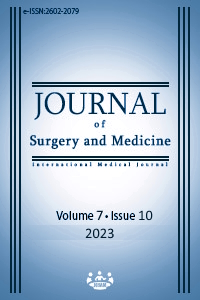Evaluation of tension-free vaginal tape and transobturator tape surgery performed in one year in terms of mesh erosion
Is the surgical method effective in mesh erosion?
Keywords:
trans-obturatar tape, suburetral slings, stress urinary incontinance, tension-free vaginal tapeAbstract
Background/Aim: Mesh erosion is one of the feared complications in surgeries performed using mesh, and its frequency is increasing as more and more of these surgeries are performed. This study aims to evaluate transobturator tape (TOT) and tension-free vaginal tape (TVT) surgeries performed in the surgical treatment of stress urinary incontinence (SUI) in our clinic in terms of clinical results and mesh erosion.
Methods: This study is a retrospective cohort study. The files of 50 patients who had SUI and underwent TOT and TVT surgery in our clinic between January 2022 and January 2023 were reviewed. Patients diagnosed with pure SUI and for whom surgery was performed were included in our study. The participants were divided into two groups: those who had TOT surgery and those who had TVT surgery. These groups were evaluated and compared in terms of mesh injury, mesh erosion, pelvic pain, dyspareunia symptoms, and urinary retention. The surgical data of patients, incidence of complications, pre- and postoperative incontinence impact questionnaires (IIQ-7) and the scores of the International Consultation on Incontinence Questionnaire Short Form (ICIQ-SF) were recorded.
Results: The mean follow-up period of the participants was 8.96 (8.47) (range, 6-17 months). TVT surgery was performed on 13 participants and TOT surgery was performed on 37 patients. When the two groups were compared, there was no statistically significant difference in terms of age, body mass index (BMI), parity, menopausal status, duration of incontinence, preoperative IIQ-7 scores, and ICIQ-SF scores (P<0.05). There were no statistically significant differences between surgical durations, length of hospital stay, early surgical complications, postoperative 3rd month IIQ-7, and ICIQ-SF scores (P<0.05). Furthermore, no difference in the rates of mesh erosion and mesh-related complications between the two groups (P<0.05) was observed.
Conclusion: TOT and TVT surgeries seem to be quite safe in terms of complications, as well as being satisfactory in terms of patient satisfaction. Although mesh-related complications can be frightening, the rate of regression is low with appropriate management. Our results show that both operations are safe with an acceptable complication rate when performed by surgeons who have experience with anti-incontinence procedures.
Downloads
References
Norton P, Brubaker L. Urinary incontinence in women. Lancet. 2006;367(9504):57-67. DOI: https://doi.org/10.1016/S0140-6736(06)67925-7
Abrams P, Cardozo L, Fall M. The standardisation of terminology of lower urinary tract function: report from the Standardisation Sub-committee of the International Continence Society. Neurourol Urodyn. 2002;21(2):167-78. DOI: https://doi.org/10.1002/nau.10052
Haylen BT, de Ridder D, Freeman RM. An International Urogynecological Association (IUGA)/International Continence Society (ICS) joint report on the terminology for female pelvic floor dysfunction. Neurourol Urodyn. 2010;29(1):4-20. DOI: https://doi.org/10.1002/nau.20798
Stothers L, Chopra A, Raz S. Vaginal reconstructive surgery for female incontinence and anterior vaginal-wall prolapse. Urol Clin North Am. 1995;22(3):641-55. DOI: https://doi.org/10.1016/S0094-0143(21)00534-6
Ulmsten U, Henriksson L, Johnson P, Varhos G. An ambulatory surgical procedure under local anesthesia for treatment of female urinary incontinence. Int Urogynecol J Pelvic Floor Dysfunct. 1996;7(2):81-6. DOI: https://doi.org/10.1007/BF01902378
Kenton K, Stoddard AM, Zyczynski H. 5-year longitudinal followup after retropubic and transobturator mid urethral slings. J Urol. 2015;193(1):203-10. DOI: https://doi.org/10.1016/j.juro.2014.08.089
Committee Opinion no. 513: vaginal placement of synthetic mesh for pelvic organ prolapse. Obstet Gynecol. 2011;118(6):1459-64. DOI: https://doi.org/10.1097/AOG.0b013e31823ed1d9
Murphy M, Holzberg A, van Raalte H. Time to rethink: an evidence-based response from pelvic surgeons to the FDA Safety Communication: "UPDATE on Serious Complications Associated with Transvaginal Placement of Surgical Mesh for Pelvic Organ Prolapse". Int Urogynecol J. 2012;23(1):5-9. DOI: https://doi.org/10.1007/s00192-011-1581-2
Cam C, Sakalli M, Ay P, Cam M, Karateke A. Validation of the short forms of the incontinence impact questionnaire (IIQ-7) and the urogenital distress inventory (UDI-6) in a Turkish population. Neurourol Urodyn. 2007;26(1):129-33. DOI: https://doi.org/10.1002/nau.20292
Çetinel B, Ozkan B, Can G. The validation study of ICIQ-SF Turkish version. Turk J Urol. 2004;30(3):332-8.
Delorme E. La bandelette trans-obturatrice: un procédé mini-invasif pour traiter l'incontinence urinaire d'effort de la femme [Transobturator urethral suspension: mini-invasive procedure in the treatment of stress urinary incontinence in women]. Prog Urol. 2001;11(6):1306-13.
Haylen BT, Freeman RM, Swift SE. An International Urogynecological Association (IUGA)/International Continence Society (ICS) joint terminology and classification of the complications related directly to the insertion of prostheses (meshes, implants, tapes) and grafts in female pelvic floor surgery. Neurourol Urodyn. 2011;30(1):2-12. DOI: https://doi.org/10.1002/nau.21036
Dindo D, Demartines N, Clavien PA. Classification of surgical complications: a new proposal with evaluation in a cohort of 6336 patients and results of a survey. Ann Surg. 2004;240(2):205-13. DOI: https://doi.org/10.1097/01.sla.0000133083.54934.ae
Murphy M, van Raalte H, Mercurio E, Haff R, Wiseman B, Lucente VR. Incontinence-related quality of life and sexual function following the tension-free vaginal tape versus the "inside-out" tension-free vaginal tape obturator. Int Urogynecol J Pelvic Floor Dysfunct. 2008;19(4):481-7. DOI: https://doi.org/10.1007/s00192-007-0482-x
Richter HE, Albo ME, Zyczynski HM. Retropubic versus transobturator midurethral slings for stress incontinence. N Engl J Med. 2010;362(22):2066-76. DOI: https://doi.org/10.1056/NEJMoa0912658
Bong GW, Rovner ES. Vaginal erosion after hybrid midurethral sling placement. Urology. 2006;68(6). DOI: https://doi.org/10.1016/j.urology.2006.09.038
Kobashi KC, Govier FE. Management of vaginal erosion of polypropylene mesh slings. J Urol. 2003;169(6):2242-3. DOI: https://doi.org/10.1097/01.ju.0000060119.43064.f6
Deval B, Haab F. Management of the complications of the synthetic slings. Curr Opin Urol. 2006;16(4):240-3. DOI: https://doi.org/10.1097/01.mou.0000232043.95427.d6
O'Kane M, Araklitis G, Rantell A, Robinson D, Cardozo L. Conservative management of intravesical erosion of a synthetic mid-urethral sling for the treatment of stress urinary incontinence, based on patient preference: A case report. Case Rep Womens Health. 2022;33:e00383. Published 2022 Jan 20. DOI: https://doi.org/10.1016/j.crwh.2022.e00383
Karram MM, Segal JL, Vassallo BJ, Kleeman SD. Complications and untoward effects of the tension-free vaginal tape procedure. Obstet Gynecol. 2003;101(5 Pt 1):929-32. DOI: https://doi.org/10.1097/00006250-200305000-00018
Kokanali MK, Doğanay M, Aksakal O, Cavkaytar S, Topçu HO, Özer İ. Risk factors for mesh erosion after vaginal sling procedures for urinary incontinence. Eur J Obstet Gynecol Reprod Biol. 2014;177:146-50. DOI: https://doi.org/10.1016/j.ejogrb.2014.03.039
Downloads
- 862 1132
Published
Issue
Section
How to Cite
License
Copyright (c) 2023 Elif Yıldız, Burcu Timur
This work is licensed under a Creative Commons Attribution-NonCommercial-NoDerivatives 4.0 International License.
















